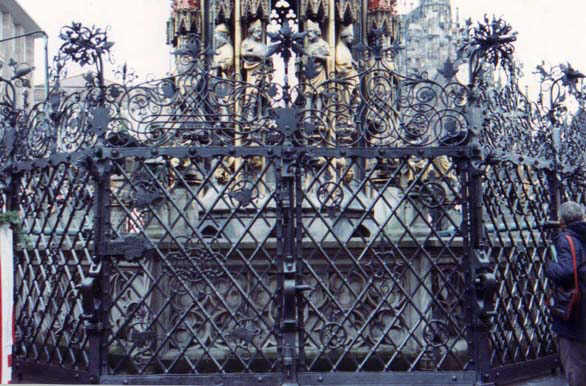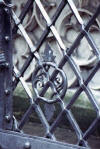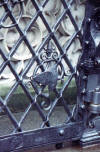Beautiful Fountain - Nurenburg, Germany
[Home] [Back
to Ironwork & Metalwork page] [Iron
& Copper Entryway Gate] [Beautiful Fountain, Nurenburg Germany]
[Modern Brass &
Glass Railing] [Baroque
Drive Gate Reproduction]
UPDATED September 16th, 2019
 Schöner Brunnen- The Beautiful Fountain
in Nuremburg, Germany, is one of the most famous examples
of German renaissance ironwork surviving to this day. Located in the Old Market
area of the medieval city of Nuremburg, in front of the Frauenkirche (Church of
Our Lady ). The church was built between the years 1355 and 1561.
Schöner Brunnen- The Beautiful Fountain
in Nuremburg, Germany, is one of the most famous examples
of German renaissance ironwork surviving to this day. Located in the Old Market
area of the medieval city of Nuremburg, in front of the Frauenkirche (Church of
Our Lady ). The church was built between the years 1355 and 1561.
The pierced bars pass through each other forming a very strong structure.
Ornaments were pierced and fitted into the latticework of the grills and each
ornament was different from the next. This style from the German renaissance
period still inspires modern ironwork. Piercing required a great deal of
mechanical knowledge and skill to allow each part to pass through the next
without binding. If just one part was off center, the whole assembly process
became difficult or impossible.
The fountain enclosure surrounds and protects the beautiful fountain within. It
is near the street and pedestrian areas of the city and since it is located
outdoors, it may be viewed all the time.



 The
famous Christkindlesmarkt takes place in this same plaza and the Beautiful
fountain and its gate and grillwork enclosure adds to the wonderful visual backdrop during the
Christmas season. Across the street we always stopped to grab sausages and gluewein (a thick spicy wine served hot), consuming them in the frosty air of
early winter while admiring the ironwork of the fountain. Then it was into the
market for a little Christmas shopping.
The
famous Christkindlesmarkt takes place in this same plaza and the Beautiful
fountain and its gate and grillwork enclosure adds to the wonderful visual backdrop during the
Christmas season. Across the street we always stopped to grab sausages and gluewein (a thick spicy wine served hot), consuming them in the frosty air of
early winter while admiring the ironwork of the fountain. Then it was into the
market for a little Christmas shopping.
Nuremburg was home to numerous great artists such as master painter Albrecht
Dürer, the sculpture Adam Kraft, woodcarver
Veit Stoss, poet Hans Sachs, explorer and cartographer Martin Behaim, and of
course the master of graffiti and inspirer of those obnoxious little self
sticking post-it notes, Martin Luther.

 The fountain was originally built in the 14th century. The gates and
grillework were made in 1587 by the Locksmith Andreas Kuhn. The top or crown of
the grill was removed later as a matter of style of the era and replaced with
the present crown in 1823 by Locksmith Pickel. For those unfamiliar with the
terminology of ironwork, a grill is the iron panel or fence-like structure or
latticework, the gate is of coarse the door structure that opens and closes, and
the crown is the fancy decorative ironwork on top of the grill and gate
structure. According to Margerete Baur-Reinholds' book Decorative Ironwork, the
Germanisches museum in Nuremburg possesses a copper plate engraving showing the
original crown that was mounted to the top of this grill previously.
The fountain was originally built in the 14th century. The gates and
grillework were made in 1587 by the Locksmith Andreas Kuhn. The top or crown of
the grill was removed later as a matter of style of the era and replaced with
the present crown in 1823 by Locksmith Pickel. For those unfamiliar with the
terminology of ironwork, a grill is the iron panel or fence-like structure or
latticework, the gate is of coarse the door structure that opens and closes, and
the crown is the fancy decorative ironwork on top of the grill and gate
structure. According to Margerete Baur-Reinholds' book Decorative Ironwork, the
Germanisches museum in Nuremburg possesses a copper plate engraving showing the
original crown that was mounted to the top of this grill previously.

 The main structure of the grillwork is composed of square bars pierced
on-the-diamond, each of which pass through each other. Pierced ironwork in which
bars of square or round cross-section was a favorite style of the Germans during
that time period and this style prevails to this day wherever smiths can be
found who are good enough to be able to do it. Decorative motifs which were also
pierced were fitted into the latticework of the grill as well. No two decorative
motifs being alike. The pierced latticework was then riveted to the frame which
itself was grooved and decoratively cut to add strength and character to the
grillwork. Heavy decorative posts or pillars support the grill and the posts
were decoratively forges and carved and topped with passion flowers.
The main structure of the grillwork is composed of square bars pierced
on-the-diamond, each of which pass through each other. Pierced ironwork in which
bars of square or round cross-section was a favorite style of the Germans during
that time period and this style prevails to this day wherever smiths can be
found who are good enough to be able to do it. Decorative motifs which were also
pierced were fitted into the latticework of the grill as well. No two decorative
motifs being alike. The pierced latticework was then riveted to the frame which
itself was grooved and decoratively cut to add strength and character to the
grillwork. Heavy decorative posts or pillars support the grill and the posts
were decoratively forges and carved and topped with passion flowers.

 The
spindle flower is a unique and characteristically German finial or fanciful
termination for a frame member or corner post. The spindle flower
represents no real existing example of plant life and yet it is remarkable in
that it creates the image of a flower made of iron, in the mind of anyone who sees it.
Each corner post is topped with a passion flower and some of the lesser vertical
frame members are as well.
The
spindle flower is a unique and characteristically German finial or fanciful
termination for a frame member or corner post. The spindle flower
represents no real existing example of plant life and yet it is remarkable in
that it creates the image of a flower made of iron, in the mind of anyone who sees it.
Each corner post is topped with a passion flower and some of the lesser vertical
frame members are as well.
 There is more than one legend that has grown around this fountain enclosure.
Each concerns the moveable brass ring placed in the crown at the right side of
the gates. One of the legends tells us the brass ring was placed there by an
apprentice who wanted to impress the master of the shop. The apprentice came into the
shop early one morning, forged the pierced ironwork and then
inserted the brass ring. How he inserted the ring is a secret. But if you reach up
and turn the ring with your hand, it will bring you good luck. It is said that
the master was pleased with his apprentices work.
There is more than one legend that has grown around this fountain enclosure.
Each concerns the moveable brass ring placed in the crown at the right side of
the gates. One of the legends tells us the brass ring was placed there by an
apprentice who wanted to impress the master of the shop. The apprentice came into the
shop early one morning, forged the pierced ironwork and then
inserted the brass ring. How he inserted the ring is a secret. But if you reach up
and turn the ring with your hand, it will bring you good luck. It is said that
the master was pleased with his apprentices work.
I am certain that this gate was quickly torn down during the second world war
and stored in a safe place as the allies needlessly bombed this city until nothing
was standing. Some signs of the restoration are still visible where the gate was
later reinstalled during the reconstruction period which followed that horrific
war. I shot plenty of photos of these modern repairs as I was curious why they
had been performed, and it was only later that I learned of the fate of this
city and saw the photos of its devastation. The people did a wonderful job of
restoring everything. Modern photos of this gate and grill
look identical to those found in old books printed before the war.
Some things were receiving still more and better restoration. While we were
visiting in 1990 and 1991, the restoration work crews had discovered the old
wine cellar beneath the courtyard of the Kaiserburg castle. The staff always
knew it existed and believed it was being used as safe storage for important
artworks and artifacts that the owners wished to protect from bombing during the
second world war. Archeologists had erected a makeshift shelter over a hole in
the pavement of the courtyard to protect the cellar from the elements as they
lowered cameras into the hole to inspect the cellar. We had to return home
before we could find out what they found.
Christ Child's Market in Nuremburg Germany, takes place each year
beginning in late November through December. Beautiful Christmas market in the medieval city of Nuremburg
Germany. For more information see
their website at
http://www.christkindlesmarkt.de/index_e.html.
In medieval Europe each town had an open street market taking place once a
day, once a week, once a month, or on some other special schedule. The
Christkindlesmarkt takes place once a year and like each town which has a
specialty or theme, the Christkindlesmarkt specialty is Christmas ornaments and
wooden toys.
Many are hand-made. The market is located in front of the Frauenkirche next to
the Beautiful Fountain. This is a wonderful time of the year to visit this
historic landmark and do some Christmas shopping at the same time.
Visit their Website even if you can't attend. Beautiful pictures and a tour
of the historical parts of the medieval city. The city of Nürnburg
is one of my favorite destinations to study medieval armour and weapons,
medieval and renaissance wrought ironwork, and castle architecture. More tourist
info is available at
http://www.nuernberg.de/english/tourismus/tourismus.html.
More photos of the Schöner Brunnen
(Beautiful Fountain) ironwork are found in Margarete Baur-Reinhold's book
Decorative Ironwork ISBN 0-7643-0153-5. I used her book as part of my
reference for this page. Additional photos can be found in books which promote
tourism in Germany and the City of Nuremburg. For additional references click
here http://www.gnm.de/indexE.htm to
see the website belonging to the Germanisches Museum in Nuremburg.
Nuremburg's tourism and city information website.
http://www.nuernberg.de/english/tourismus/tourismus.html
Kaiserburg castle information page can be accessed through the tourism and
information page above or click here
http://www.museumsgalore.nuremberg.de/kaiserburgmuseum/index.html. They have
photos of some of their collection including armour, at that website.
Latest update
September 16, 2019.
The author can be emailed at address in picture below:

This page originally created December 17th, 2001.
 Schöner Brunnen- The Beautiful Fountain
in Nuremburg, Germany, is one of the most famous examples
of German renaissance ironwork surviving to this day. Located in the Old Market
area of the medieval city of Nuremburg, in front of the Frauenkirche (Church of
Our Lady ). The church was built between the years 1355 and 1561.
Schöner Brunnen- The Beautiful Fountain
in Nuremburg, Germany, is one of the most famous examples
of German renaissance ironwork surviving to this day. Located in the Old Market
area of the medieval city of Nuremburg, in front of the Frauenkirche (Church of
Our Lady ). The church was built between the years 1355 and 1561. 









